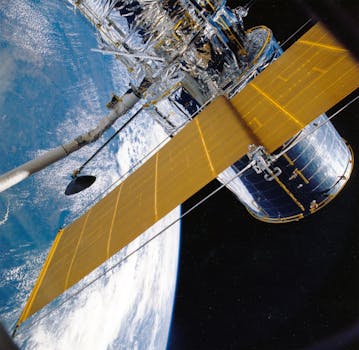From Geostationary to Low Earth Orbit: The Evolution of Satellite Telecommunications in 2023

From Geostationary to Low Earth Orbit: The Evolution of Satellite Telecommunications in 2023
Satellite telecommunications, low earth orbit, and geostationary orbit are the focus of this article, which delves into the evolution of satellite telecommunications in 2023. The satellite telecommunications industry has undergone significant evolution in recent years, with a shift from geostationary to low earth orbit. This transition has been driven by advancements in technology, changes in consumer demand, and the need for more efficient and cost-effective solutions.
The traditional geostationary orbit has been the backbone of the satellite telecommunications industry for decades. Geostationary satellites are placed at an altitude of approximately 36,000 kilometers, which allows them to maintain a fixed position in the sky and provide continuous coverage to a specific region. However, this type of orbit has several limitations, including high latency, limited bandwidth, and high operating costs.
In recent years, there has been a significant shift towards low earth orbit (LEO) satellites. LEO satellites are placed at an altitude of approximately 160-2,000 kilometers, which allows them to provide lower latency, higher bandwidth, and more efficient use of spectrum. LEO satellites also have the advantage of being smaller and less expensive to launch, which makes them an attractive option for new entrants in the market.
The Benefits of Low Earth Orbit Satellites
The benefits of LEO satellites are numerous. One of the most significant advantages is the reduction in latency. LEO satellites have a latency of around 20-30 milliseconds, which is significantly lower than the 200-300 milliseconds experienced by geostationary satellites. This makes LEO satellites ideal for real-time applications such as video conferencing, online gaming, and virtual reality.
Another benefit of LEO satellites is the increase in bandwidth. LEO satellites can provide higher bandwidth than geostationary satellites, which makes them ideal for applications such as broadband internet, video streaming, and data transfer. LEO satellites also have the advantage of being able to provide coverage to remote and underserved areas, where traditional telecommunications infrastructure is lacking.
Challenges and Opportunities
Despite the benefits of LEO satellites, there are several challenges that need to be addressed. One of the most significant challenges is the need for a large constellation of satellites to provide continuous coverage. This requires significant investment in infrastructure, including the launch of multiple satellites and the development of complex ground systems.
Another challenge is the issue of interference. LEO satellites operate in a crowded frequency band, which can lead to interference from other satellites and terrestrial systems. This requires careful planning and management of spectrum resources to ensure that LEO satellites can operate efficiently and effectively.
Conclusion
In conclusion, the evolution of satellite telecommunications from geostationary to low earth orbit is a significant development that has the potential to transform the industry. LEO satellites offer several benefits, including lower latency, higher bandwidth, and more efficient use of spectrum. However, there are also several challenges that need to be addressed, including the need for a large constellation of satellites and the issue of interference. As the industry continues to evolve, it is likely that we will see significant advancements in technology and innovation, which will help to address these challenges and unlock the full potential of LEO satellites.




